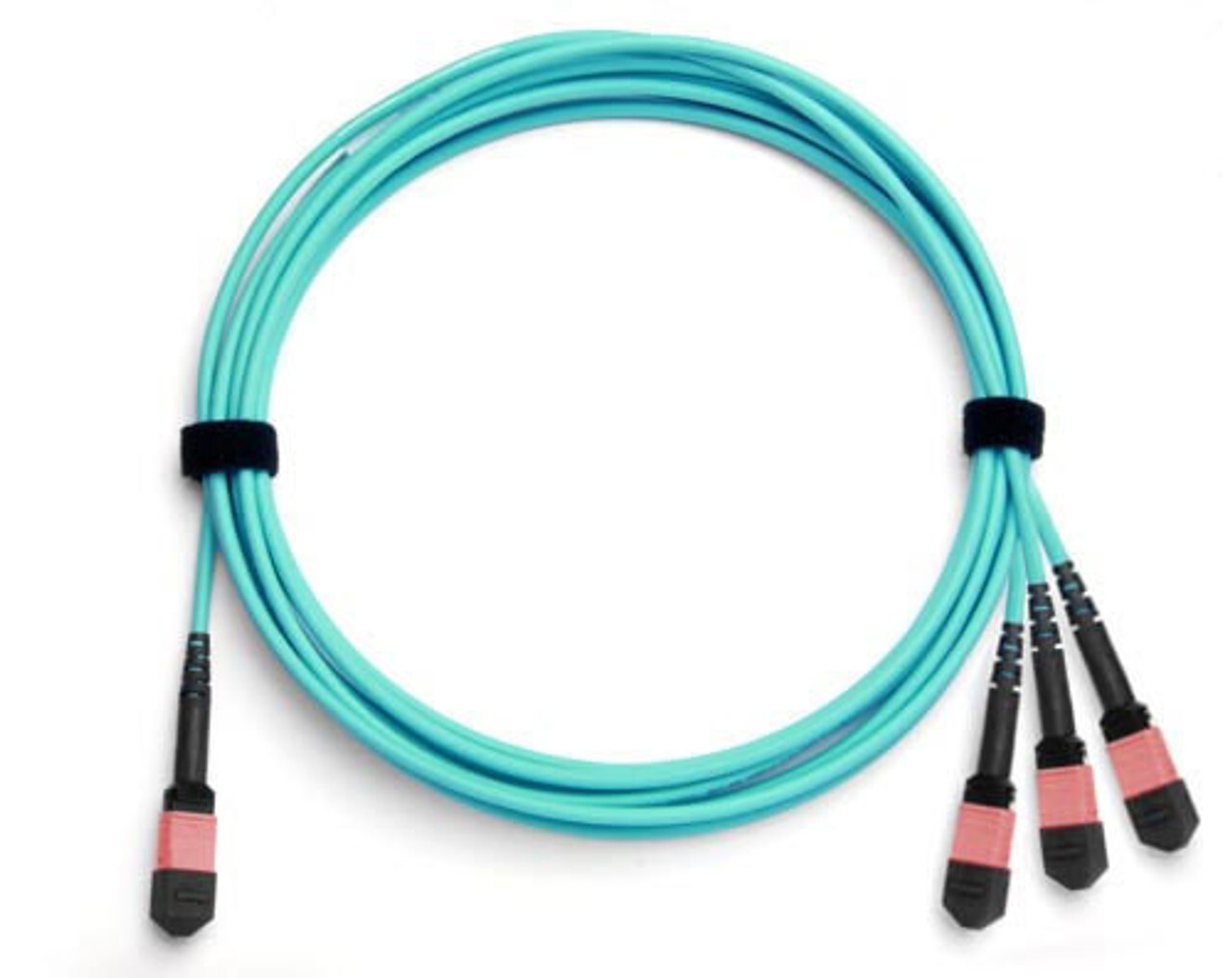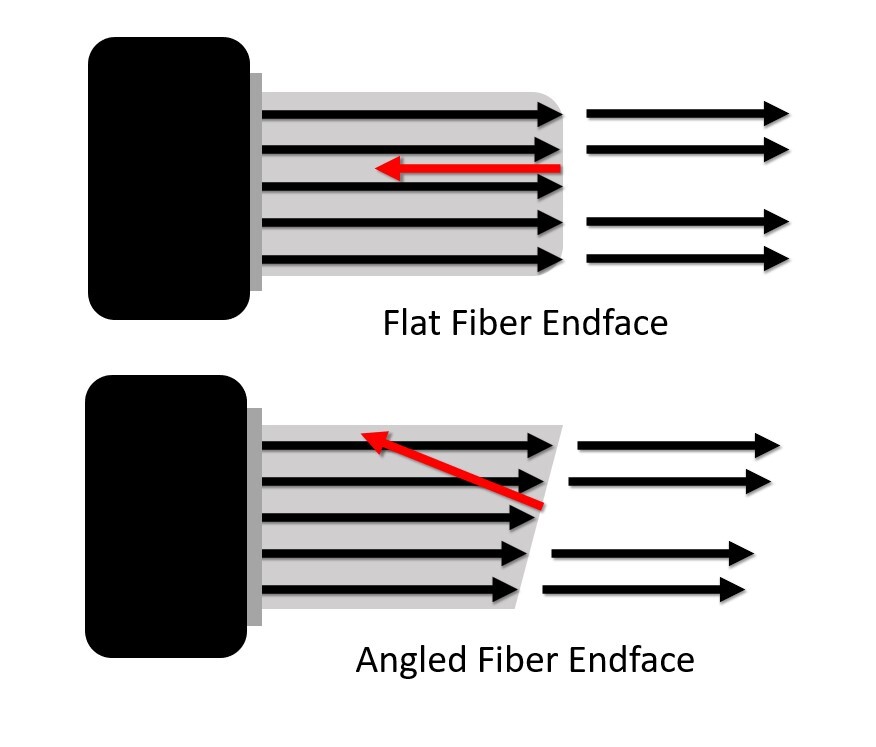
Data centers contain multiple switch layers to efficiently route data and optimize network performance, scalability, and utilization of resources. Access-layer switches move large volumes of data from servers to aggregation and core layer switches that consolidate and transmit data to and from other data centers, storage area networks (SANs), backend high-performance computing (HPC) networks, and the cloud.
As the adoption of 5G, IoT, cloud computing, and HPC technologies like artificial intelligence (AI) continue to grow, data centers are tasked with efficiently transmitting ever-increasing amounts of data between switch layers. Switch-to-switch speeds in the data center are rapidly migrating from 100 Gig to 200 and 400 Gigabit (Gig) speeds to support bandwidth demands, with 800 Gig already deployed for switch-to-switch connections in HPC environments and 1.6 Terabit on the horizon. These high-speed links rely on multi-fiber MTP/MPO connectivity, and there are several considerations for choosing the best MTP/MPO cables for your critical data center switch-to-switch connections.
Types of MTP/MPO Cables
MTP/MPO fiber cables for switch-to-switch connections are plenum-rated for indoor environments and come in both singlemode fiber (OS2) and multimode fiber (OM3, OM4, and OM5). With minimized differential mode delay (DMM) to support longer distances, OM4 is the primary fiber type used in most multimode MTP/MPO cables. Cables with OM5 fiber are optimized for short wavelength division multiplexing (SWDM) that transmits data on multiple wavelengths, enabling longer distances for these applications. You can learn more about multimode fiber cabling types in our previous blog.
MTP/MPO cables are also available in a variety of standard lengths, or they can be made to order in customized lengths. They come in strand counts from 8 to 144 fibers and are factory-terminated to 8-, 12-, 16-, or 24-fiber MTP/MPO connectors. Higher-count cables feature multiple fibers under a single sheath with multiple connectors on each end. For example, a 72-fiber MTP/MPO cable typically has six (6) 12-fiber MTP/MPO connectors on each end. Multi-fiber connector types could also be traditional MTP/MPO connectors or newer very-small form factor (VSFF) 16-fiber connectors such as US Conec’s MMC, offering three times more port density due to their smaller size.
 MTP/MPO cables for switch-to-switch connections can be purchased as trunk cables with the same MTP/MPO connectors on both ends or as breakout cables with different connectors on each end. Breakout cables (also called fan-out cables) connect a higher-speed switch port to multiple lower-speed servers or switches to maximize port density and utilization. While most breakout cables feature MTP/MPO connectors on one end and multiple duplex connectors on the other end for connecting to lower-speed 25, 50, and 100 Gig servers, they can also be used for switch-to-switch connections. For example, a breakout cable can have a 16- or 24-fiber MTP/MPO connector on one end that breaks out to multiple 8- or 12-fiber MTP/MPO connectors. Learn more about MTP/MPO trunk cables versus breakout cables in our previous blog.
MTP/MPO cables for switch-to-switch connections can be purchased as trunk cables with the same MTP/MPO connectors on both ends or as breakout cables with different connectors on each end. Breakout cables (also called fan-out cables) connect a higher-speed switch port to multiple lower-speed servers or switches to maximize port density and utilization. While most breakout cables feature MTP/MPO connectors on one end and multiple duplex connectors on the other end for connecting to lower-speed 25, 50, and 100 Gig servers, they can also be used for switch-to-switch connections. For example, a breakout cable can have a 16- or 24-fiber MTP/MPO connector on one end that breaks out to multiple 8- or 12-fiber MTP/MPO connectors. Learn more about MTP/MPO trunk cables versus breakout cables in our previous blog.
How to Choose the Right MTP/MPO Cable
Choosing MTP/MPO cables for switch-to-switch connections is, first and foremost, based on the application that needs to be supported. Several factors influence application deployment, including transmission speed, distance between switches, cost, and density.
Both multimode and singlemode MTP/MPO fiber cables support 200, 400, and 800 Gig, but distances vary. For 100 Gig or higher switch-to-switch links, multimode fiber is limited to 100 meters, while singlemode fiber can support much longer distances of up to 40 kilometers. Most switch-to-switch link distances in the data center are easily supported by multimode fiber, but larger cloud and hyperscale data centers may need to choose a singlemode application if distances exceed 100 meters.
Cost is a significant consideration when it comes to application. Longer-reach singlemode applications use WDM technology with switches that can cost up to five times more than multimode equipment. To cost-effectively support higher-speed switch-to-switch links beyond 100 meters, short-reach DR singlemode applications are an excellent option. These applications support up to 500 meters using power-conserving lasers that are less expensive and consume less power than longer-reach singlemode lasers. Short-reach VR multimode applications are the most cost-optimized solution for very short switch-to-switch links that are less than 50 meters.
The number of fibers and type of connector interface also vary depending on the application. For example, 8-fiber MTP/MPO connectors support 200 and 400 Gig SR4, VR4, and DR4 applications, with 4 fibers transmitting and 4 receiving at a lane speed of 50 or 100 Gb/s. In contrast, 800 Gig SR8, VR8, and DR8 applications require 16 fibers, with 8 fibers transmitting and 8 receiving at a lane speed of 100 Gb/s. These applications can be supported with two 8-fiber MTP/MPO connectors, a 16-fiber MTP/MPO connector, or a 16-fiber VSFF MMC connector. The connector interface must also match what it connects to, whether a switch port or patch panel. VSFF connectors like the MMC are ideal for supporting 16-fiber connections on ultra-high-density switches and in patching areas.
The table below shows the latest multimode and singlemode applications for 200, 400, and 800 Gig switch-to-switch links using MTP/MPO cables.
|
MULTIMODE APPLICATIONS |
|||
|
Application |
Distance (Meters) |
# of Fibers |
Connector |
|
200GBASE-SR4 |
70 m (OM3) 100 m (OM4/OM5) |
8 |
MPO-8 |
|
400GBASE-SR4.2 |
70 m (OM3) 100 m (OM4) 150 m (OM5) |
8 |
MPO-8 |
|
400GBASE-SR8 |
70 m (OM3) 100 m (OM4/OM5) |
16 |
MPO-16, MMC |
|
400GBASE-VR4 |
30 m (OM3) 50 m (OM4/OM5) |
8 |
MPO-8 |
|
800GBASE-SR8 |
60 m (OM3) 100 m (OM4/OM5) |
16 |
MPO-16, MMC |
|
SINGLEMODE APPLICATIONS |
|||
|
Application |
Distance (Meters) |
# of Fibers |
Connector |
|
200GBASE-DR4 |
500 m |
8 |
MPO-8 |
|
400GBASE-DR4 |
500 m |
8 |
MPO-8 |
|
800GBASE-DR8 |
500 m |
16 |
MPO-16, MMC |
Other Key Considerations
Additional factors should be considered when choosing MTP/MPO cables for switch-to-switch connections. If you’re using breakout applications to connect a higher-speed port to multiple lower-speed ports, you need the right MTP/MPO cable based on your configuration. Breakout configurations typically include 2X100 Gig, 4X100 Gig, 2X200 Gig, or 2X400 Gig for switch-to-switch connections. For example, a 4X100 Gig breakout cable will have an 8-fiber MTP/MPO connector on one end and four (4) duplex connectors on the other. HPC environments like AI clusters often deploy higher-speed 2X400 Gig breakout applications using MTP/MPO breakout cables with a 16-fiber MTP/MPO connector on one end and two (2) 8-fiber MTP/MPO connectors on the other end.
Other considerations when choosing MTP/MPO connectors is whether the connector endface is UPC (ultra physical contact) or APC (angled physical contact). The angled endface of APC connectors reduces reflectance. While flat UPC fiber endfaces support multimode applications, APC fiber endfaces are required for singlemode applications because they are more susceptible to reflectance. APC fiber endfaces are also often recommended for 400 and 800 Gig multimode. It’s imperative to know whether the endface that an MTP/MPO cable is mating with is APC or UPC and ensure you select the matching type. Connecting a UPC endface with an APC endface will cause signal degradation and potentially damage the connector.

Of course, when choosing an MTP/MPO cable, it’s essential always to consider performance and quality since switch-to-switch connections are the backbone of a data center. To ensure data center uptime and reliability, choose only MTP/MPO cables constructed from high-quality fiber with precision optical components, proven reliability, and superior insertion loss performance.
The good news is that CablesPlus is a premier supplier of multimode and singlemode MTP/MPO cables with the ability to custom build the length and configuration you need for your data center switch-to-switch connections—all backed by our commitment to quality using only state-of-the-art precision components. Contact us today for all MTP/MPO cabling needs.
Explore Our Complete Range of MTP/MPO Cables Contact an Expert

